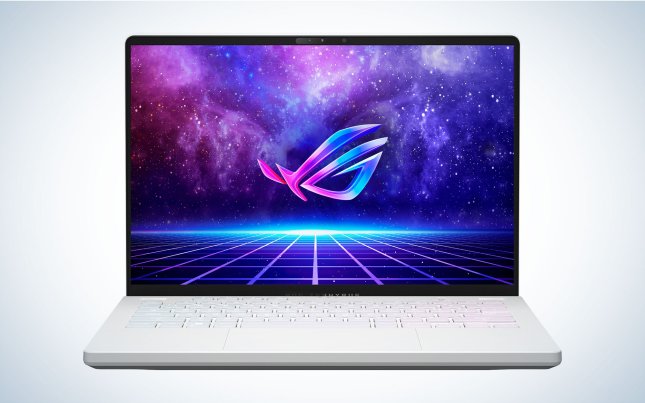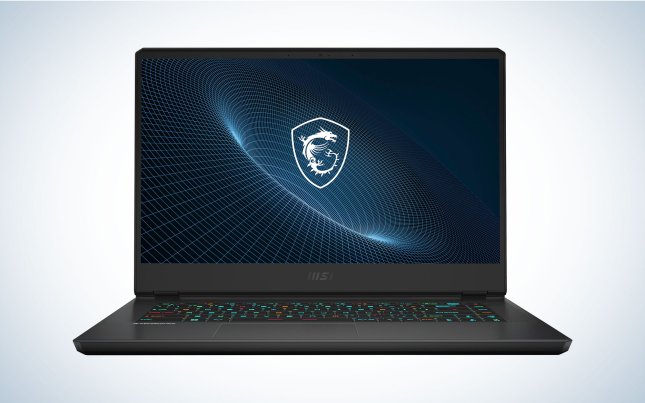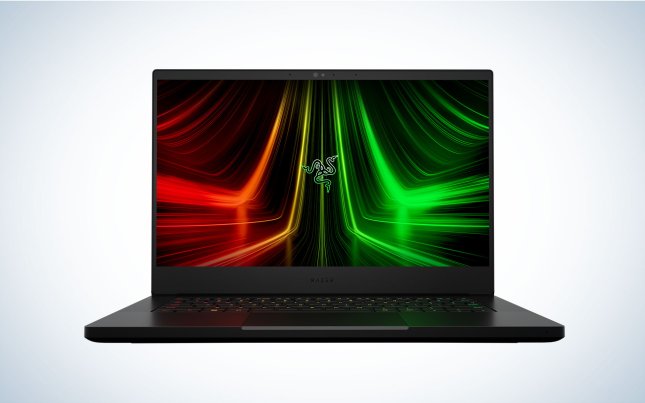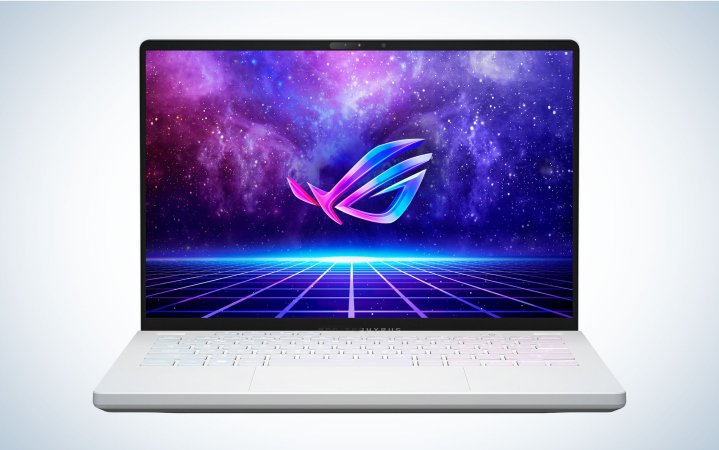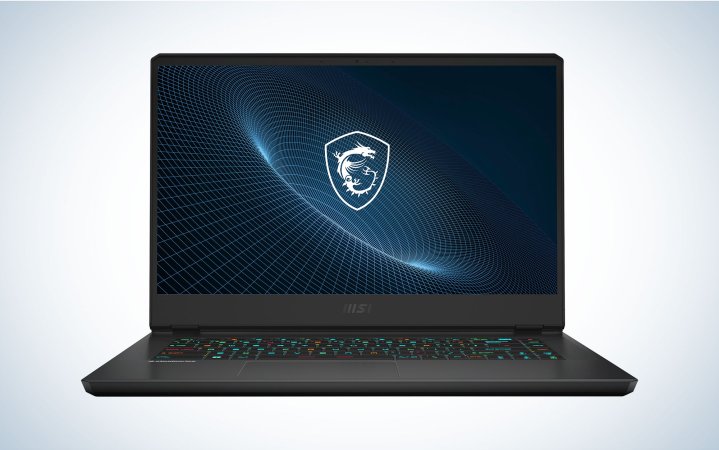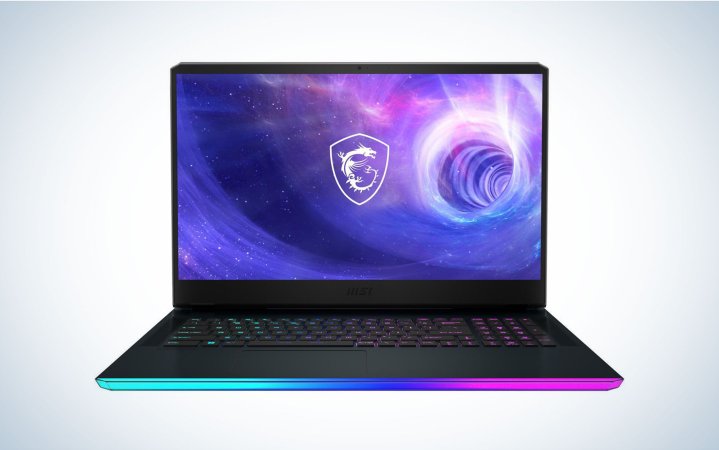We may earn revenue from the products available on this page and participate in affiliate programs. Learn more ›
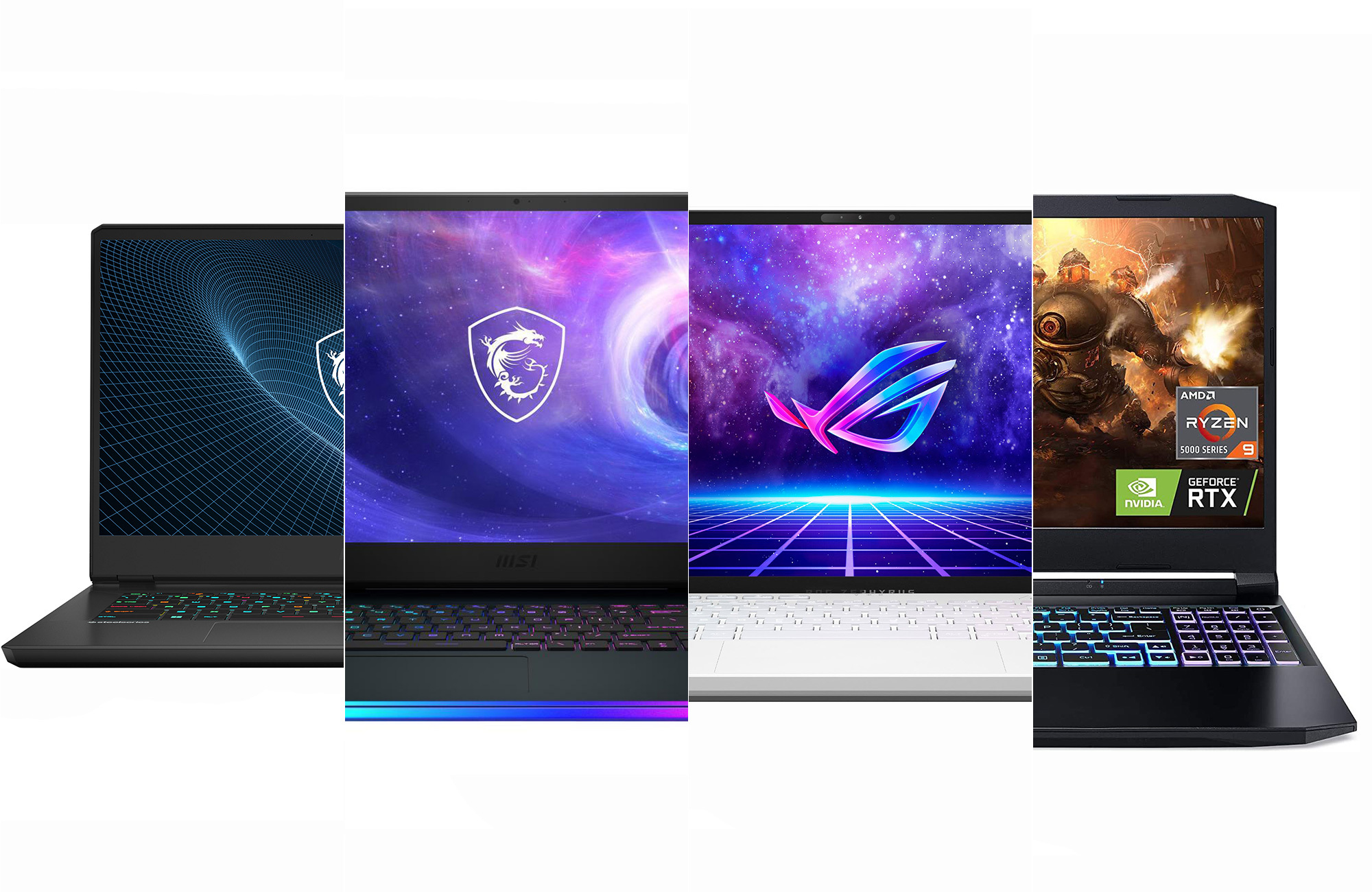
Gaming on the go has never been so good as it is with the current generation of laptops. Whether you’re a student, someone who travels for work, or even just a PC gamer that may not want to be locked to a desk, being able to play PC games anywhere you may roam is a compelling proposition. And thanks to big leaps forward in mobile gaming technology, it’s more possible than ever to have a full PC gaming experience wherever you go. If you’re looking to find a little more flexibility in where you play, we’ve collected the top choices available today to make shopping for the best gaming laptops fast and easy.
- Best overall: ASUS ROG Zephyrus G14 (2022)
- Best for processing power: MSI Vector GP66 (2022)
- Best for gaming and school: Acer Nitro 5 (2021)
- Best for gaming and work: Razer Blade 14 (2022)
- Best 17-inch: MSI GE76 Raider (2022)
- Best budget: ASUS TUF Gaming F17 (2021)
How we selected the best gaming laptops
I’ve been a PC enthusiast since the early 2000s when I won my first personal computer from a school competition. Ever since, I’ve been doing everything I can to go hands-on with machines, building and tinkering, and exploring what makes them tick. It didn’t take long for me to develop a passion for PC gaming, which quickly led to me buying a gaming laptop to take that experience everywhere I go. And so, another hobby was born.
Since that time, I’ve joined the tech press and have been lucky enough to test multiple generations of gaming laptops and components across a number of major sites (PopSci, IGN, Reviewed, and more). I’ve taken that knowledge and experience and applied it here, taking a close look at the hardware in each machine considered, how it works together, and how it can work to enhance your gaming experience.
Things to consider before buying one of the best gaming laptops
Buying a gaming laptop can get more than a little confusing. Brands love to throw numbers and specifications into their marketing materials without ever explaining how they will enhance your gaming experience in real terms. They also love to highlight cosmetic features like RGB lighting that, while possibly neat, don’t matter as much as the components that make the machine run well. Here’s what to look for in the best gaming laptop:
Processor (CPU)
The processor, or CPU, is the brain of your computer. There are two major companies producing laptop CPUs today: Intel and AMD. Both brands break their processors into different performance tiers. For Intel, the most common are Core i3, Core i5, Core i7, and Core i9. For AMD, those are Ryzen 3, Ryzen 5, Ryzen 7, and Ryzen 9. All of those chips scale up in performance (and price), often with more cores and threads and higher speeds. For gaming, we recommend getting a PC with Core i5 and Ryzen 5 or above for the best performance.
When comparing processors, examining the number of processing units, or “cores,” will tell you how fast your computer will handle complex tasks, like video rendering, and when handling multiple programs at once. For gaming, you want at least four cores. Players who also want to create content for YouTube or livestream on Twitch should probably hold out for at least six, or even eight cores.
The other factor to consider is clock speed. The speed of a processor, measured in Gigahertz (GHz), tells you how many computations it can complete in a second. Games tend to benefit from higher clock speed more than higher core count, but don’t choose a processor on speed alone. That said, some games, such as Microsoft Flight Simulator, are beginning to take advantage of processors with more than four cores, so aim for six cores or higher for the best performance.
Independent of those core specs, newer processors are generally better than older ones. Each generation of processors brings with it a suite of improvements that also increase its performance. As a rule, consider what you’ll be doing with your PC and settle on core count first. Then, choose the most recent, fastest processor you can afford within your budget.
If you’re stuck between two similar processors from AMD and Intel, consider how you plan to use your new PC. Ryzen 3000 and 5000 series processors compete very well with Intel’s top-tier CPUs in gaming, but Intel tends to squeeze out slightly higher in-game frame rates. Ryzen CPUs, on the other hand, are typically better for multicore performance, so creators may find AMD fits their needs better.
Graphics Card (GPU)
The graphics card, or GPU, is arguably the most important component for any gaming laptop. The graphics card renders 3D graphics, which makes it indispensable when making games run. It’s the most important factor in determining your in-game frame rate. Graphics cards can either be a standalone component or integrated into the processor. When shopping for a gaming PC, always invest in the best graphics card you can afford.
Laptop GPUs are produced by two key companies: AMD (the same one that makes Ryzen processors) and Nvidia. Like processors, their cards are broken into different performance tiers indicated within their names. Generally speaking, the higher the number is in the name of the card, the better performance it will offer.
AMD currently manufactures the Radeon 6000 series, so all of its mobile GPUs fall within the 6000 numbering scheme: RX 6600M, 6700M, and 6800M, to name a few. The higher the last three digits, the better in terms of performance. The laptop versions of AMD GPUs have a few extra quirks to be aware of here. If the card has an “S” next to its name (such as the RX 6800S), it means that it’s made for slim laptops and will likely perform slightly below its full-size “M” counterpart. Conversely, a card with an “XT” in its name means it will perform slightly better than a normal “M” card.
Nvidia follows similar principles with its naming conventions. Its graphics cards are part of the RTX lineup, which are ray-tracing enabled and can use machine-learning enhanced features, like Deep Learning Super Sampling (DLSS), to intelligently upscale games to higher resolutions without the usual performance hit. Its cards are currently part of the RTX 3000-series: RTX 3060, RTX 3070, RTX 3080, to name a few. Like AMD, the higher the last three digits, the better, with the only addendum being the “Ti” branding, which indicates better performance.
Within the current generation, Nvidia still offers better performance at any given level (RTX 3060 vs RX 6600, 3070 vs 6700, etc). DLSS also makes a substantial difference for laptops, especially high-end models with a 1440p or 4K screen. Games that support it (which is growing but not all-inclusive) allow you to set the game to a lower resolution and then use machine learning to upscale it in a tremendous balance of great visuals with dramatically improved performance. AMD offers a similar feature called FidelityFX Super Resolution, but the performance benefits and final image quality just aren’t as good at this point in time.
Regardless, for the best in-game performance and visuals, choose the most powerful graphics card you can afford. To game at 1080p at high settings, aim for at least a Radeon RX 6700M or RTX 3060.
Memory
Memory, or DRAM, is another important component in a gaming laptop and can be thought of as your computer’s short-term memory. The more memory your system has, the more information it can “hold” at any given time—up to a certain point. At the time of this writing, 8GB is the bare minimum required for a great gaming experience, with 16GB or even 32GB being preferred should you want to stream or multitask while playing. Some systems offer 64GB configurations, but unless you’re performing advanced tasks like rendering 3D models or working in creative suites, it’s unlikely you would ever utilize such a high amount.
More affordable laptops tend to limit the amount of memory included in their systems out of the box. If you need to save money upfront, opting for a system with 8GB of memory is a good way to do so, but may limit your system’s long-term viability. Some new laptops allow you to add more memory over time, allowing you to upgrade memory over time. That’s not universal, however, and can be a challenging task with the potential to void your warranty. If you aren’t comfortable opening your PC or aren’t sure if it supports adding more, it’s best to save up for the amount of memory you’ll need from the beginning.
The final thing to consider is what generation of memory the laptop uses. The latest generation of computer memory, DDR5, typically runs at higher speeds than the last generation’s DDR4 memory. DDR5 is still trickling out and is usually found on high-end laptop configurations. If you’re looking at a mid-to-high-end system, it’s worth splurging on the upgrade if your budget allows. Faster memory tends to result in slightly higher frame rates, and spending extra on DDR5 will help ensure your new laptop remains capable of playing top-tier games for longer. Still, the current performance gains aren’t groundbreaking (usually only a few FPS), so if given a choice between DDR5 and a better core component, invest the extra funds where you’ll see more of a return.
Screen size, resolution, and refresh rate
Laptop screens come in many sizes and varieties. They don’t all perform equally for gaming. Laptop displays usually range from 13-17 inches, but many users find that aiming for the middle, 15 inches, provides a good sweet spot for gaming and portability. Smaller and, especially, larger screens impact usability and overall weight, so it’s a good idea to consider what you actually need. A 17-inch screen might seem great for immersive gaming, but it’s going to require more bag space and may not leave room for a mouse on a small desk. If you’re not sure what size you need, we recommend visiting a store and seeing the different varieties in person to get a feel for what works best for you.
Beyond that, judging a laptop display feels just like picking the best gaming monitor. That means you should pay close attention to your display’s refresh rate, which determines how many times your laptop can redraw its screen in a single second. Most normal laptops run at 60Hz, which means the image refreshes 60 times a second. That also means games can only run at up to 60 FPS, even if your laptop can produce more. Gaming laptops often feature extended refresh rates of 120Hz, 144Hz, 240Hz, or even 360Hz. These result in smoother motion in games and minor improvements to responsiveness. It also means they can display higher FPS, up to their rated refresh rate.
Before spending extra on a 240Hz gaming laptop, consider the games you’re playing and what kind of FPS you’re likely to get. If your laptop only has an RTX 3070 and you plan on playing the latest, most demanding games, you’ll rarely even hit 120 FPS, let alone 240 or 360. That said, opting for a 120Hz and 144Hz display provides a noticeable improvement to smoothness in normal use compared to 60Hz, so still enhances how pleasant the system is to use. Beyond that, the improvements are much more subtle and won’t be utilized outside of easy to run esports titles.
Battery
You always want to look for the best battery life in any electronic device, but it is especially important for a gaming laptop. Demanding components like standalone graphics cards and powerful processors drain a battery quickly, so it’s always wise to have a charger on hand before jumping into your favorite game. Since chargers can be bulky and plugging in isn’t always possible, we recommend looking for a laptop that offers at least 50wHr of juice and preferably as much as possible beyond that.
Even a large battery can be run dry in an hour or two of intense gaming, however, so keep an eye out for supporting features like USB Type-C charging. Combined with a high-watt GaN charger, this feature will allow you to leave the bulky power supply at home and instead stay charged with a power brick not much bigger than the one for your smartphone.
Connectivity
If you plan on plugging in peripherals or an external hard drive, be sure to take a close look at the connectivity of the laptop you’re considering. To keep things thin and light, many laptops limit the number of ports they include. Also, take note of where those ports are. A right-side USB port might not seem like a problem, but if you also plan to use a normal mouse, the protruding plug can quickly become a nuisance. Gaming laptops like the ASUS ROG Zephyrus G15 tend to have more ports than normal notebooks, but still look closely and compare to what you’ll actually be using.
Weight
While the rest of the laptop world continues to march toward ever thinner and lighter designs, gaming laptops often prioritize power over portability. Powerful components generate a lot of heat, so gaming laptops need advanced cooling solutions, which add weight and thickness to the design.
If you plan on traveling with your laptop, you’ll need to hunt for one that keeps weight down without sacrificing power. They exist but are often among the most expensive options on the market. The MSI GS66 Stealth manages to pack cutting-edge hardware into a frame that’s only 18mm thick and 4.6 pounds.
If you hunt for them, you can find a middle ground, though. The Lenovo Legion 5, a laptop that is comparatively heavy by modern standards, only tips the scales at 5.29 pounds. You’ll feel it in your bag (and back) more than the GS66, but it’s still a very manageable weight for the level of performance it offers. As with screen size, we recommend visiting a physical store to pick up a prospective laptop (or a similar model) to get a feel for what you’re signing up to carry.
The best gaming laptops: Reviews & Recommendations
Now that you know what to look for, it’s time to choose the best gaming laptop for you. We’ve collected the best choices across half a dozen key categories. Whether you’re looking for a powerful machine to replace your desktop, an understated notebook that can double for work or school, or the best gaming laptop you can find on a budget, this list has something for you.
Best overall: ASUS ROG Zephyrus G14 (2022)
The Full Package
Why it made the cut: This 14-inch laptop combines outstanding performance and portability, all for a reasonable price.
Specs
- Price: $1,899.99
- Display: 14-inch, 120Hz, 2560×1600 (1600p)
- GPU: Radeon RX 6800S
- CPU: AMD Ryzen 9 6900HS
- Memory: 16GB DDR5
- Storage: 1TB NVMe SSD
Pros
- Exceptionally powerful
- Lightweight and portable
- Great for gamers and content creators
- Uses a minimalist design that’s great for class and work
Cons
- Slightly less powerful 6800S variant
- Only 16GB or memory
If you’re looking for a cutting-edge laptop that won’t leave tumbleweeds in your bank account, the ASUS ROG Zephyrus G14 is the one to get. Delivering incredible balance and high performance, it can play the latest games at high settings but that won’t attract attention if you’d like to use it at the office. It also offers exceptional battery life thanks to its ability to switch between the powerful dedicated GPU for gaming and the power-sipping integrated GPU for productivity.
Under the hood, the Zephyrus G14 has all the horsepower you’ll need to play the latest games at high frame rates. Its dedicated Radeon RX 6800S graphics card isn’t quite as powerful as the thicker RX 6800M, but it’s plenty to deliver excellent gameplay even in demanding titles. Thanks to its 1600p, 120Hz display, those games will look crisper and smoother than ever. More importantly, it allows this laptop to weigh in at only 3.64 pounds and measure 0.73-inches thick. Add to that AMD’s latest Ryzen 9 6900HS processor and you have a machine that’s capable enough for anything you’d like to throw at it, including streaming and video editing. It’s an incredible value for the $1,899.99 asking price.
The biggest downside to this laptop is that it only includes 16GB of DDR5 memory. This is perfectly fine for gaming but may strain under the pressure of major streaming and video editing projects. Thankfully, the Zephyrus G14 also supports expandable memory, so you can swap out one of its 8GB sticks for a larger size anytime you like.
Best for processing power: MSI Vector GP66
Powerful Processing
Why it made the cut: The MSI Vector GP66 packs Intel’s latest 12-generation Core i9 CPU into a package that expertly balances performance and price.
Specs
- Price: $2,199.99
- Display: 15.6-inch, 360Hz, 1920×1080 (1080p)
- GPU: Nvidia RTX 3070 Ti
- CPU: Intel Core i9-12900H
- Memory: 32GB DDR4
- Storage: 1TB NVMe SSD
Pros
- High-performance Intel Core i9 processor
- Ultra-high refresh rate screen
- 32GB of memory
- Excellent performance
Cons
- Fan noise
- DDR4 memory
- Odd configuration options that limit GPU/CPU
The MSI Vector GP66 packs Intel’s most powerful 12th-generation mobile processor, the beastly Core i9-12900H, making it a processing powerhouse. This CPU tops out at 5GHz and is one of the very best for in-game frame rates available right now. It also features Intel’s latest design that splits a whopping 14 cores (individual processing units important for games and programs) into different performance groups to ensure smooth, rapid performance whether you’re gaming or cutting together your latest YouTube video. At $2,199, the Vector GP66 is a stellar balance of industry-leading processing power and price.
This particular configuration is paired with the RTX 3070 Ti, which is more than enough to handle 1080p gaming at high settings and opens the door to advanced features like DLSS upscaling to further improve gaming performance. What’s more, the design of the GP66’s fans allows it to stay cool enough to draw more power and eke out higher in-game FPS than many other laptops with this GPU. The display is also clocked to 360Hz, so you can count on reduced motion blur in esports titles.
The GP66 is powerful, but it’s not without its shortcomings. Despite featuring a 12th-generation Intel processor, it still uses older DDR4 memory. Keeping that GPU cool also results in quite a bit of fan noise. Our friends at Notebook Check measured it at 58dB, which will absolutely be noticeable without headphones and to those around you.
Another oddity with this laptop is its configuration options. MSI forces you to choose a powerful CPU (Core i7 or Core i9) or GPU (RTX 3070 or RTX 3080) without giving you an option for both. Our choice here is based on the balance of price and performance but if you want the best of both worlds, the Gigabyte Aero 16 is a tremendous alternative that upgrades the processor to an overclockable variant and steps up the graphics card to an RTX 3080 Ti. Of course, all of that comes at an equally colossal $4,299.
Best for gaming and school: Acer Nitro 5 (2021)
Big Laptop on Campus
Why it made the cut: The Acer Nitro 5 (2021) is a desktop replacement perfect for cramped dorm rooms and slung backpacks.
Specs
- Price: $2,368.36
- Display: 15.6-inch, 165Hz, 2560×1440 (1440p)
- GPU: Nvidia RTX 3080
- CPU: AMD Ryzen 9 5900HX
- Memory: 32GB DDR4
- Storage: 1TB NVMe SSD
Pros
- Outstanding gaming performance
- Reasonably light
- Less garish than older Nitro laptops
Cons
- Still has a bright red accent
- Display isn’t very bright
- Cramped keyboard
The 2021 version of Acer’s Nitro 5 laptop design packs a performance punch. Between its powerful graphics card, processor, expansive SSD, and plentiful memory, it’s able to completely replace a desktop, which is perfect for a small dorm room where every square foot counts. It’s also fairly light at only 4.8 pounds, so it won’t leave your back aching after carrying it to and from classes.
The combination of specs really can’t be overstated. The Nitro 5 features a fast 165Hz screen with a crisp 1440p resolution for extra detail in games. The RTX 3080 GPU is powerful enough to stand up to even the most demanding games today and can take full advantage of that high refresh rate screen. The processor adds to this with eight cores and sixteen threads (virtual cores important for demanding applications and games), which even makes streaming from college a real possibility. This combination is also the perfect fit for students who may be majoring in digital art or game design. Students without the room for a bulky desktop won’t have to sacrifice much performance at all when they take this on the go.
Though the Nitro 5 is less outspoken than previous Nitro models, it’s still unmistakably a gaming laptop with its bright red rear accent. Users and professional reviews also note that the screen lacks brightness compared to its competitors. Some users might appreciate the full-size keyboard with a number pad, but cramming the extra keys in makes the typing feel a bit more cramped than most laptops. It’s still perfectly usable but might take some getting used to in the first few days after taking it home.
Best for gaming and work: Razer Blade 14 (2022)
Work by Day, Game by Night
Why it made the cut: The Razer Blade 14 is made for the rigors of day-to-day life. Work, gaming, and everything in between, this portable laptop delivers.
Specs
- Price: $2649.00
- Display: 14-inch, 165Hz, 2560×1440 (1440p)
- GPU: Nvidia RTX 3080
- CPU: AMD Ryzen 9 5900HX
- Memory: 16GB DDR4
- Storage: 1TB NVMe SSD
Pros
- Powerful, especially for its size
- Very portable
- Durable (mostly understated) construction
- 1440p screen is especially crisp
Cons
- May need to turn down the resolution when gaming
- Noisy fan when gaming
- Only 16GB of non-expandable RAM
If you’re looking for a gaming laptop that can double as an office notebook, the Razer Blade 14 is for you. This small laptop comes in at only 14 inches and 3.92 pounds, making it exceptionally portable. It features all-metal construction for added durability and peace of mind during your daily commute. It also includes a satisfyingly tactile keyboard to make typing out reports and emails a little less arduous.
Small in stature, the Razer Blade 14 lacks nothing in performance. It features an AMD latest Ryzen 9 5900HX processor, which offers great gaming performance and enough horsepower for streaming, video editing, and digital artwork. It also features an expansive 1TB NVMe SSD to store all of your files and photos without needing to invest in external storage (and one more thing to carry). The Blade 14 comes with 16GB of DDR4 memory, which is enough productivity and gaming (though isn’t expandable). The model we’ve selected features an RTX 3080 and a crisp 1440p display that looks stunning in person. Hitting triple-digit frame rates may require you to lower graphics settings or play at 1080p resolution, however.
Fitting all of that hardware into such a small body makes venting heat a challenge with that powerful GPU. As a result, the fans can get quite noisy when gaming, so you’ll want to sit away from roommates and pick up a pair of headphones if you’re sensitive to extra noise. Likewise, though it’s possible to stretch the battery life out to the 12 hours Razer claims, you’ll need to turn down the brightness and refresh rate of the screen to achieve it. It is possible, however, and the benefits in size, portability, and power are hard to argue with.
Best 17-inch: MSI GE76 Raider (2022)
The Big-Screen Experience
Why it made the cut: The MSI GE76 Raider is a top-of-the-line gaming laptop that leaves nothing on the table. This is the laptop to push laptop gaming to the limit.
Specs
- Price: $2,999.99
- Display: 17.3-inch, 120Hz, 2560 x 1440 (1440p)
- GPU: Nvidia RTX 3070 Ti
- CPU: Intel Core i9-12900Hk
- Memory: 32GB DDR5
- Storage: 1TB NVMe SSD
Pros
- Outstanding performance
- Beautiful screen
- Sleek design
- Great speakers
- 1080p webcam
Cons
- Extremely expensive
- Cramped keyboard
- Middling battery life
The MSI GE76 Raider delivers the full desktop experience in a portable form factor. Its gorgeous 17.3-inch screen will take up more of your field of view than gaming laptops up close. More importantly, its eye-popping 1440p, 240Hz display is a rarity among 17-inch laptops. Add to that a good set of speakers and a great webcam and you have the makings for a laptop that can become a lynchpin in your entertainment life.
MSI made zero compromises on the hardware powering this admittedly expensive machine. Inside its well-ventilated chassis, the GE76 Raider features an overclockable Intel Core i9 12900HK processor and an Nvidia RTX 3070 Ti laptop GPU. MSI tops it off with 32GB of fast DDR5 memory (expandable up to 64GB) and a big 1TB NVMe SSD, so you don’t have to worry about filling any of this system’s memory any time soon.
Of course, all that power takes its toll on battery life. Our colleagues at PC World said it lasts about 6 1/2 hours on a full charge. The keyboard is also rather cramped, making way for a full-size number pad for macros and productivity. Still, this is an immensely powerful computer, and these concerns feel like nitpicks compared to the advantages it offers.
Best budget: Asus TUF Gaming F17 (2021)
Big Screen, Small Spend
Why it made the cut: The Asus TUF Gaming F17 is a well-rounded gaming laptop that will let you play games on the go without feeling guilty about how much you’ve spent.
Specs
- Price: $999.99
- Display: 17.3-inch, 144Hz, 1920×1080 (1080p)
- GPU: Nvidia RTX 3050 Ti
- CPU: Intel Core i5-11260H
- Memory: 8GB DDR4
- Storage: 512GB NVMe SSD
Pros
- Well-priced
- Large, high refresh rate screen
- Plentiful connectivity options
- Solid processor for gaming
Cons
- Poor battery life
- Only 8GB of memory
- Middling GPU
The 2021 ASUS TUF Gaming F17 is a great entry point to the world of portable PC gaming. Starting at $999.99 (and regularly on sale for less), this laptop boasts just enough hardware prowess to get you into the game and show you just what’s made so many people fall in love with PC gaming. You’ll need to turn down some settings, but the value the F17 brings is hard to argue with.
For its relatively modest cost, the F17 offers a lot. You get a big 144Hz screen. Its CPU has six cores, which is sufficient for virtually every game out there. The 8GB of memory it comes with isn’t that impressive but is enough for gaming alone and can be expanded up to 32GB if you don’t mind installing your own (or paying the local computer shop to do it for you). It even features a current-generation graphics card, the RTX 3050 Ti. Sure, it won’t push the latest games with great FPS at their highest settings, but most will certainly be playable, and thanks to DLSS upscaling, it’s even possible to turn the graphics up even higher in games that support it.
As a larger gaming laptop, battery life is a problem, though. Its battery is a relatively meager 48wHr and won’t last more than an hour or two when gaming. Lowering screen brightness and refresh rate will certainly help battery life, but gaming away from an outlet is sure to be short-lived. Even with that being the case, the F17 remains one of the best values in gaming laptops that include a current-generation GPU.
FAQs
The most important component in a gaming laptop is the graphics card. The processor is a close second, followed by memory. All three components work together to run your games and create a fluid experience. The GPU takes priority when you’re making a hard choice, though, as it does the heavy lifting in most games. Put simply, you can have a great processor and heaps of memory, but without a good graphics card, the laptop won’t perform well.
There is no best screen size for a gaming laptop, but most users find 15-inches to be a perfect middle ground between size and portability. If you’re looking for something extra portable, a 14-inch laptop is usually easier to carry and weighs less. Getting a larger 17-inch laptop allows the screen to take up more of your field of view and can lead to a more immersive gaming experience, but usually at the expense of bag space and increased weight. Smaller laptops, like Razer’s 13-inch, Razer Book, can certainly be used for gaming but the smaller screen size isn’t ideal to take in everything occurring on the screen, particularly in competitive titles.
Unless you’re buying a laptop with a cutting-edge graphics card, gaming at 4K will be difficult. 4K resolution can look stunning but requires cutting-edge hardware, such as the Nvidia RTX 3080 Ti found in the Razer Blade 15 or RTX 3080 in the ASUS ROG Zephyrus G15. Even with these high-powered laptops, you should plan on turning down graphics settings to achieve the best performance in the latest games.
That said, there are still reasons to buy a laptop with a 4K screen. With four times the pixels as a 1080p screen, they look unquestionably sharper. Watching movies, taking in photos, and creating digital art are all enhanced by the higher resolution. Since gaming at 4K is so much more demanding, many gamers decide to use a lower resolution when gaming and switch back for performing other activities.
Final thoughts on the best gaming laptops
Gaming laptops have never been so powerful, which makes it the perfect time to pick one up and try for yourself. The very best don’t come cheap, but even affordable laptops can offer great experiences if you don’t mind turning down some settings. If you find yourself traveling, or just don’t want to deal with the bulk of a full-size gaming PC, picking up the best gaming laptop for you is a liberating choice that opens the doors to portable gaming for years to come.
